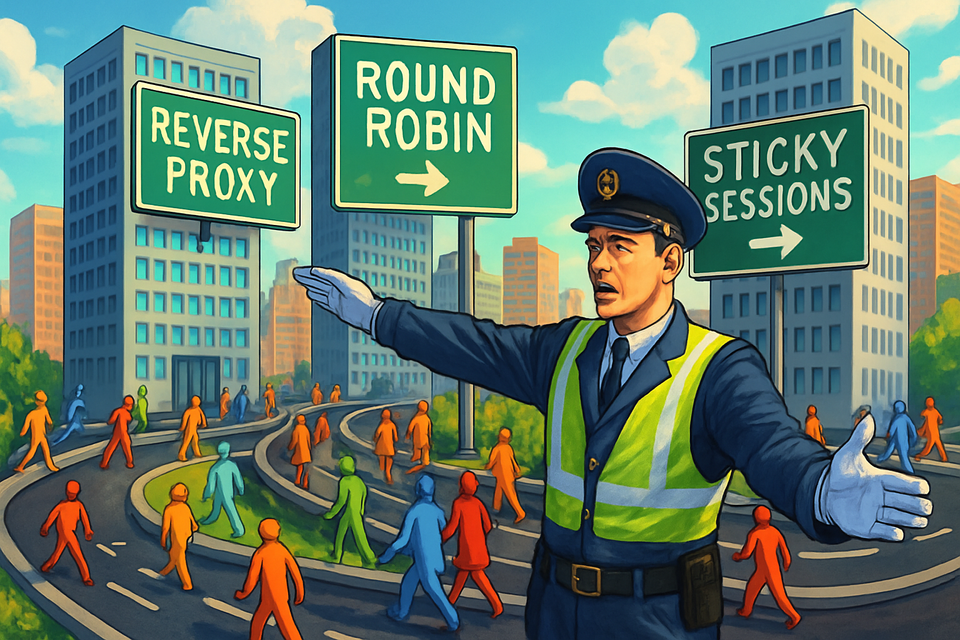Load Balancers: Traffic Police of the Internet

Ever wonder how websites manage to stay fast and responsive even when thousands (okay, maybe millions) of people are visiting at the same time? Have you ever noticed how your favorite online store doesn’t crash even when there’s a big sale happening? The secret behind this magic is something called a load balancer — the unsung traffic police of the internet.
Let’s break down what load balancers do, why they matter, and some cool tricks they have up their sleeve, like reverse proxies, round robin, and sticky sessions — all explained in a friendly, easy way.
What’s a Load Balancer? (Imagine the Traffic Police)
Think of a load balancer as a traffic cop standing at a busy intersection during rush hour. Instead of letting all the cars pile up in one lane, the traffic cop directs each car to different lanes — so no one lane gets a traffic jam, and everything flows smoothly.
Websites and apps get tons of visitors at once, and load balancers make sure all those requests don’t overwhelm a single server. Instead, they distribute the incoming traffic evenly across multiple servers, keeping things speedy and preventing crashes.
Why Do We Need Load Balancers?
Imagine an ice cream shop with just one clerk. On a hot summer day with a long line, that clerk would get overwhelmed, and impatient customers would leave. Now imagine the same shop with many clerks handling customers simultaneously — the line moves faster and everyone gets their ice cream without waiting forever.
Web servers are the clerks here, and visitors are the customers. Load balancers help by:
- Distributing traffic among servers so no single server gets overworked.
- Increasing availability and reliability — if one server goes down, others can pick up the slack.
- Improving speed and user experience by avoiding bottlenecks.
Simply put, load balancers keep websites fast, even when traffic spikes.
The Reverse Proxy: The Friendly Middleman
Here’s a cool concept: a reverse proxy. It’s like a friendly receptionist at a company’s front desk. When a visitor shows up, this receptionist decides which employee (server) the visitor should meet, keeps sensitive info secure, and sometimes even answers simple questions on their own.
A reverse proxy sits between users and servers. When you send a request (like clicking “Buy Now”), it intercepts the request first, then forwards it to the right server based on rules. It also sends the server’s response back to you, hiding which server actually processed the request.
Why use a reverse proxy?
- Adds security by hiding internal server details.
- Can handle SSL encryption to keep data safe.
- Manages caching and compression to speed up responses.
Think of a reverse proxy as the clever gatekeeper making sure traffic flows smoothly and securely.
You can also read a nice comparison between proxy and reverse proxy

Round Robin: The Fair Traffic Cop
Now, how does the load balancer decide who gets what request? The simplest method is called round robin — like a traffic cop waving cars into lanes one by one, in a fair and orderly circle.
With round robin, each incoming request is forwarded to the next server in line, cycling through all servers evenly. So, if you have three servers, the first request goes to Server 1, second to Server 2, third to Server 3, then back to Server 1, and so on.
This is great when:
- Servers have roughly the same capacity.
- Traffic is consistent and evenly distributed.
Round robin is simple, effective, and often the default load balancing method.
Round Robin: Keeping Things Cozy
But wait — what happens when you’re shopping online, and you add something to your cart? You expect that cart to stick around as you browse more pages, right? This is where sticky sessions come in.
Sticky sessions (sometimes called session persistence) make sure that once a user’s request goes to a certain server, all their future requests during that session go to the same server. This “sticking” helps servers remember your activity and data without confusion.
How does it work? Usually, a tiny cookie or session ID tracks which server you’re “stuck” to. Every time you interact, that info tells the load balancer: "Send this user back to Server X."
Sticky sessions matter for:
- Shopping carts on e-commerce sites.
- User login sessions.
- Anything where keeping a continuous connection matters.
The trade-off? Sticky sessions can sometimes lead to uneven load if many users stick with one server, but they’re vital for smooth user experiences.
Real-World Example — Load Balancer in Action
Picture you're visiting a popular news website when a big breaking story drops. Suddenly thousands race to read it. Behind the scenes, the load balancer kicks in:
- Visitors’ requests flood the site’s URL.
- The load balancer receives all these requests first.
- It uses round robin or other methods to spread the load across multiple web servers.
- The reverse proxy masks the server locations and handles security.
- For logged-in users, sticky sessions keep their experience seamless.
- If a server crashes (because overloaded or maintenance), the load balancer reroutes requests to healthy servers.
Without load balancers, this site might crash or slow to a crawl. With them? Smooth sailing, even at peak times.
Why Should You Care?
Because nearly every fast, reliable website or app uses load balancers to keep things running — including ones you use daily, like shopping sites, social media, streaming platforms, and more.
Understanding what load balancers do helps you appreciate the invisible traffic police working round the clock, managing the chaotic rush of internet traffic. Plus, if you’re dabbling with building websites or apps, knowing load balancing basics sets you apart.


Member discussion